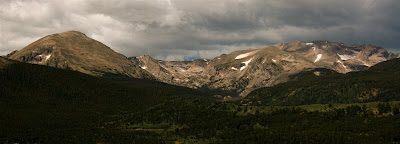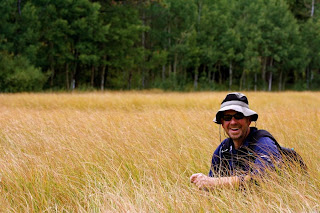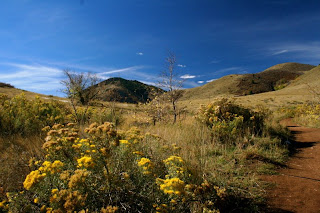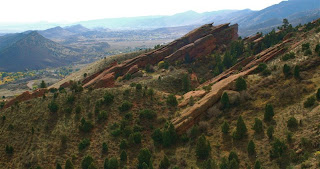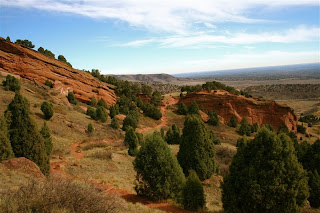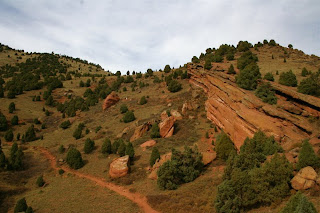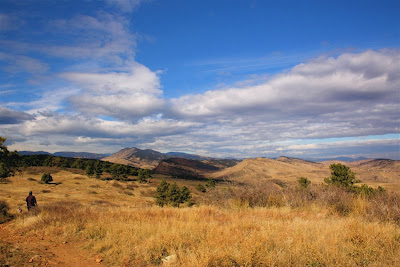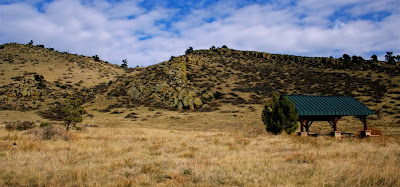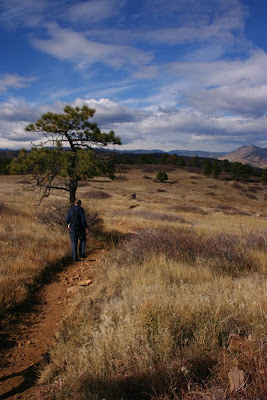Distance: 6 miles RT
Elevation: 5,960 – 6,420 ft
Elevation Gain: 460 ft

Ralph Pierce Reservoir viewed from the Sleepy Lion Trail. You can see Mt. Meeker in the distance.
Button Rock is a delightful and lesser-known open space just west of Lyons. It is dog friendly, contains views of distant
Twin Sisters, and skirts a narrow reservoir bordered by pine trees. It is another of my favorite shoulder season hikes.
 Creek along the initial part of the trail to the dam
Creek along the initial part of the trail to the damThe trail starts off in a large dirt parking area surround by high cliffs. On the west side of a wide gate, a broad flat road heads east towards the Ralph Price Reservoir. The road transects the canyon and with several interesting water features. If you continue heading west, you will end up at the base of the dam, but for a more interesting route, take the Sleep Lion Trail around a half-mile up the road. A large sign marks the trail.
 These man made falls are about half-way to the Sleepy Lion turn off.
These man made falls are about half-way to the Sleepy Lion turn off. Rocks along the Sleepy Lion Trail
Rocks along the Sleepy Lion TrailThe Sleepy Lion Trail winds through Ponderosa and Douglas fir. There are occasional open meadows and isolated red boulder formations. At the high point you can see the tip of Mt. Meeker and the double hump of Twin Sisters. There are also views of the reservoir itself.
 Twin Sisters in the distance
Twin Sisters in the distanceFrom the highest vantage, the trail descends down and old rail bed to the base of the dam. Here a dramatic jet of water shoots out of the reservoir’s water control feature. It is difficult to pull oneself away from the chaotic and powerful display of man’s attempt to control nature.
 The Ralph Pierce Reservoir seen from the Sleepy Lion Trail
The Ralph Pierce Reservoir seen from the Sleepy Lion TrailOn the far right-hand side of the dam is a short but steep trail up to the reservoir itself. This ascends several hundred feet through several highly eroded areas. Anyone used to Colorado’s steep ascents will find this short jaunt to be trivial. For those who wish an outing that is easier on the knees, skip the trail and head back down the broad road to the trail head.
 The old rail bed portion of the Sleepy Lion Trail
The old rail bed portion of the Sleepy Lion TrailThe Ralph Price Reservoir is an interesting and rarely visited place. There is no official trail that circumnavigates it, but you can walk along the right shoreline for a mile or so. In low years, there are boulders to nestle in and in high years, the deep blue waters of the reservoir lap the shoreline almost to the level of the trail. If the wind is not blowing too much, this is a pleasant place for a picnic.
 Water jet
Water jet Base of the Button Rock Dam
Base of the Button Rock DamTo return to the trail head, the hiker has two options, he can return down to the base of the dam via the steep trail or wander up and around to one of the dirt roads that skirt the area.
 The deep blue of the Ralph Pierce Reservoir
The deep blue of the Ralph Pierce ReservoirOn a sunny fall day, Button Rock can be a pleasant Front Range excursion. While known to the locals, it is rarely visited by those outside of Lyons. This does not mean that it will be uncrowded, however, but I have found that most visitors stay on the main road and do not take the more scenic but more strenuous Sleep Lion Trail.




